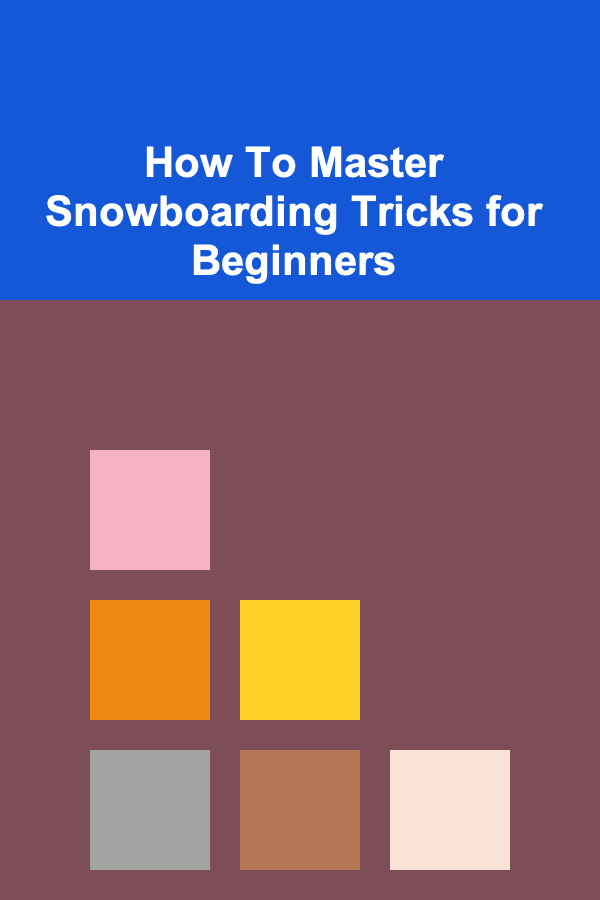
How To Master Snowboarding Tricks for Beginners
ebook include PDF & Audio bundle (Micro Guide)
$12.99$6.99
Limited Time Offer! Order within the next:

Snowboarding is an exciting and adrenaline-pumping winter sport that has captured the hearts of thrill-seekers worldwide. Whether you're sliding down a gentle slope or carving your way through fresh powder, snowboarding offers an exhilarating way to connect with the mountains and challenge yourself. However, for many beginners, the path from simply riding down the slope to mastering impressive tricks can seem intimidating. With the right guidance and mindset, you can start mastering basic tricks, gradually progressing to more complex ones.
In this article, we'll explore everything you need to know about mastering snowboarding tricks as a beginner. From understanding the fundamentals to learning specific tricks and building confidence on the snow, we will break down each step to ensure you improve safely and effectively.
Understanding the Basics of Snowboarding
Before diving into tricks, it's crucial to master the basic skills required to snowboard. Here's what you should focus on as a beginner:
1.1. Stance and Balance
The first step to becoming a proficient snowboarder is understanding your stance. You'll need to determine whether you ride with your left foot forward (regular stance) or right foot forward (goofy stance). To figure this out, stand up straight and have someone gently push you from behind. The foot you step forward with will be your leading foot.
Once you know your stance, practicing balance is crucial. Snowboarding relies on shifting your weight and maintaining equilibrium. Start on flat ground, practicing shifting your weight from your front foot to your back foot, getting a feel for the board's responsiveness.
1.2. Turning and Carving
Turning is one of the fundamental skills you'll need to master before attempting any tricks. Carving, or making sharp turns using the edge of your snowboard, is an essential technique that helps you maintain control while riding down the slope. Practice turning in both directions: toe edge (leaning forward) and heel edge (leaning back). This control over turning will give you confidence when you start attempting more advanced maneuvers.
1.3. Getting Comfortable on the Snow
Spending time on the slopes to become comfortable with the snow and your snowboard is essential. Before progressing to tricks, ensure you're confident in controlling your speed and stopping. Mastering the basics will help you stay in control when attempting tricks later on. If you're unsure about some aspects of snowboarding, don't hesitate to take a lesson with an instructor.
Preparing for Snowboarding Tricks
Once you're comfortable with the basic snowboarding techniques, it's time to prepare for your first trick. Mastering snowboarding tricks requires not only physical strength but also mental focus and confidence. Here's how you can prepare:
2.1. Strength and Flexibility Training
Snowboarding tricks require a combination of strength, balance, and flexibility. To excel at them, it's important to incorporate fitness routines that target your legs, core, and upper body. Exercises like squats, lunges, planks, and leg raises can help build the muscle strength required for controlling your snowboard.
Additionally, increasing your flexibility through stretching or yoga can help improve your range of motion, which is crucial for maintaining balance and performing specific movements when attempting tricks.
2.2. Mental Preparation
Confidence is key when performing snowboarding tricks. It's common to feel nervous when learning new skills, but a positive mindset can make a huge difference. Before attempting a trick, visualize the motion in your mind. Think about the steps involved, the position of your body, and how to land safely. By practicing visualization, you can calm your nerves and improve your execution.
Essential Snowboarding Tricks for Beginners
Now that you have the right mindset and physical preparation, let's dive into some of the essential tricks for beginners. These tricks will form the foundation of your snowboarding progression.
3.1. The Ollie
The Ollie is one of the most basic and essential tricks in snowboarding. It's a technique where you use the edge of the snowboard to launch yourself into the air without any external assistance (like a ramp or a jump). Here's how you can learn to Ollie:
- Positioning: Begin by riding at a comfortable speed on a flat section of the slope. Keep your knees slightly bent and your weight centered over the board.
- The Pop: To perform the Ollie, press down on your back foot and shift your weight to the tail of the snowboard. This will create a "pop" that launches the board into the air.
- The Jump: As the board leaves the ground, use your front foot to level the snowboard in the air. Tuck your knees slightly to help with balance.
- Landing: Aim to land with your knees slightly bent to absorb the impact and maintain your balance.
The Ollie is a fundamental trick that opens up the possibility of more advanced moves, such as jumping onto rails or doing spins.
3.2. The Nollie
The Nollie is similar to the Ollie but involves using the front foot to pop the board off the ground, rather than the back foot. To execute a Nollie:
- Positioning: Ride with your weight centered over the board.
- The Pop: Push down with your front foot to lift the nose of the board off the snow.
- The Jump: As you pop, use your back foot to guide the snowboard into the air.
- Landing: Like the Ollie, land with bent knees and stay centered over the board.
The Nollie is a great trick to practice because it helps develop control and familiarity with the board's movements. It's especially useful for jumping onto obstacles or executing different spins.
3.3. The 180
The 180 is one of the first rotational tricks you'll learn on a snowboard. It involves spinning 180 degrees in the air, either frontside (spinning in the direction you're facing) or backside (spinning the opposite direction). Here's how to get started:
- Approach: Ride at a moderate speed, with your knees slightly bent and your body loose.
- Initiate the Spin: To spin, you'll need to rotate your shoulders and hips. For a frontside 180, look over your shoulder in the direction you want to spin (towards your toes). For a backside 180, rotate your shoulders and hips in the opposite direction.
- The Jump: As you start spinning, press your back foot down to help you pop into the air. Use your arms to help initiate the rotation.
- Landing: Once you've completed the 180-degree rotation, focus on landing with your knees bent and your weight centered.
The 180 is a crucial trick that sets the stage for more advanced spins and grabs.
3.4. The Nose Press and Tail Press
Presses involve lifting the nose or tail of the snowboard while maintaining a low and stable body position. These tricks are often performed on flat terrain or over small obstacles, such as snow mounds or boxes. To perform a nose press:
- Positioning: Ride with your weight slightly shifted towards the front of the board.
- The Press: As you approach the obstacle or flat area, gently shift your weight forward to press down on the nose of the board. Try to keep the tail elevated off the snow.
- Balancing: Stay low to the ground and keep your body centered to maintain balance. Press the nose down while keeping the tail in the air.
The tail press is similar but focuses on the rear of the board. You can experiment with these presses to develop balance and control while performing tricks.
3.5. The Shifty
A Shifty is a trick where you rotate your body while keeping your snowboard mostly in place, resulting in a "shifty" motion. This trick is often used as a setup for other aerial tricks. To perform a Shifty:
- Positioning: Ride in a relaxed stance at a moderate speed.
- The Shifty Motion: Jump into the air while rotating your body 90 degrees, but keep your snowboard relatively level. The goal is to shift your body position without spinning the board completely.
- Landing: After completing the motion, land with your body facing forward and your knees bent for stability.
The Shifty is a great trick to practice for beginners because it helps develop the balance and coordination necessary for other aerial maneuvers.
Tips for Improving Your Trick Mastery
Mastering snowboarding tricks requires consistent practice and dedication. Here are some tips to help you improve:
4.1. Start Slow and Gradual
It's tempting to jump straight into advanced tricks, but starting with the basics and mastering foundational skills will pay off in the long run. Gradually progress through tricks, adding complexity as you become more comfortable and confident.
4.2. Take Lessons
If possible, take lessons from an experienced instructor. They can provide personalized feedback, helping you correct form and technique that might be difficult to notice on your own.
4.3. Practice on Various Terrain
Don't limit yourself to one type of terrain. Practice your tricks on different slopes, terrains, and obstacles to build versatility and adaptability. This will help you become a more well-rounded rider.
4.4. Record Your Progress
Use a GoPro or any action camera to record your snowboarding sessions. Watching your footage can give you insights into areas where you need improvement. You can also track your progress as you master new tricks.
4.5. Stay Safe
Always prioritize safety while learning tricks. Wear the proper protective gear, including a helmet, wrist guards, and knee pads. Start practicing in areas designated for beginners or intermediate riders to avoid accidents.
Conclusion
Mastering snowboarding tricks as a beginner takes time, patience, and dedication, but the journey is well worth the effort. By focusing on building your basic skills first, practicing regularly, and progressing gradually, you'll be able to perform a variety of tricks that will impress both yourself and others. Remember that everyone's snowboarding journey is unique, so enjoy the process and keep challenging yourself to improve.
Reading More From Our Other Websites
- [Tiny Home Living Tip 101] Best Ways to Maximize Natural Light in Your Tiny Home
- [Personal Investment 101] How to Review and Adjust Your Investment Strategy Annually
- [Home Family Activity 101] How to Design DIY Family Board Games: Fun and Creativity
- [Home Staging 101] How to Stage Your Home to Stand Out in a Competitive Market
- [Home Space Saving 101] How to Maximize Space with Stackable Washer and Dryer Units
- [Home Storage Solution 101] How to Use Multi-Purpose Furniture for Better Storage
- [Tie-Dyeing Tip 101] Best Tie‑Dye Color Theory Tips for Complementary Festival Outfits
- [Home Party Planning 101] How to Organize a Virtual Party for Friends at Home
- [Organization Tip 101] What Inspirational Quotes Can Motivate You to Stay Organized?
- [Small Business 101] Top Mistakes to Avoid When Creating a Small Business Marketing Plan

How to Build a Robust Financial Emergency Plan
Read More
How To Prevent Acid Reflux Naturally
Read More
How To Master Building a Brand Around Your POD Products
Read More
How to Maintain Your Mop for Optimal Floor Cleaning
Read More
10 Essential To-Do Items for Remote Job Interview Success
Read More
10 Essential Items to Add to Your Home Buying Checklist for Rural Properties
Read MoreOther Products

How to Build a Robust Financial Emergency Plan
Read More
How To Prevent Acid Reflux Naturally
Read More
How To Master Building a Brand Around Your POD Products
Read More
How to Maintain Your Mop for Optimal Floor Cleaning
Read More
10 Essential To-Do Items for Remote Job Interview Success
Read More